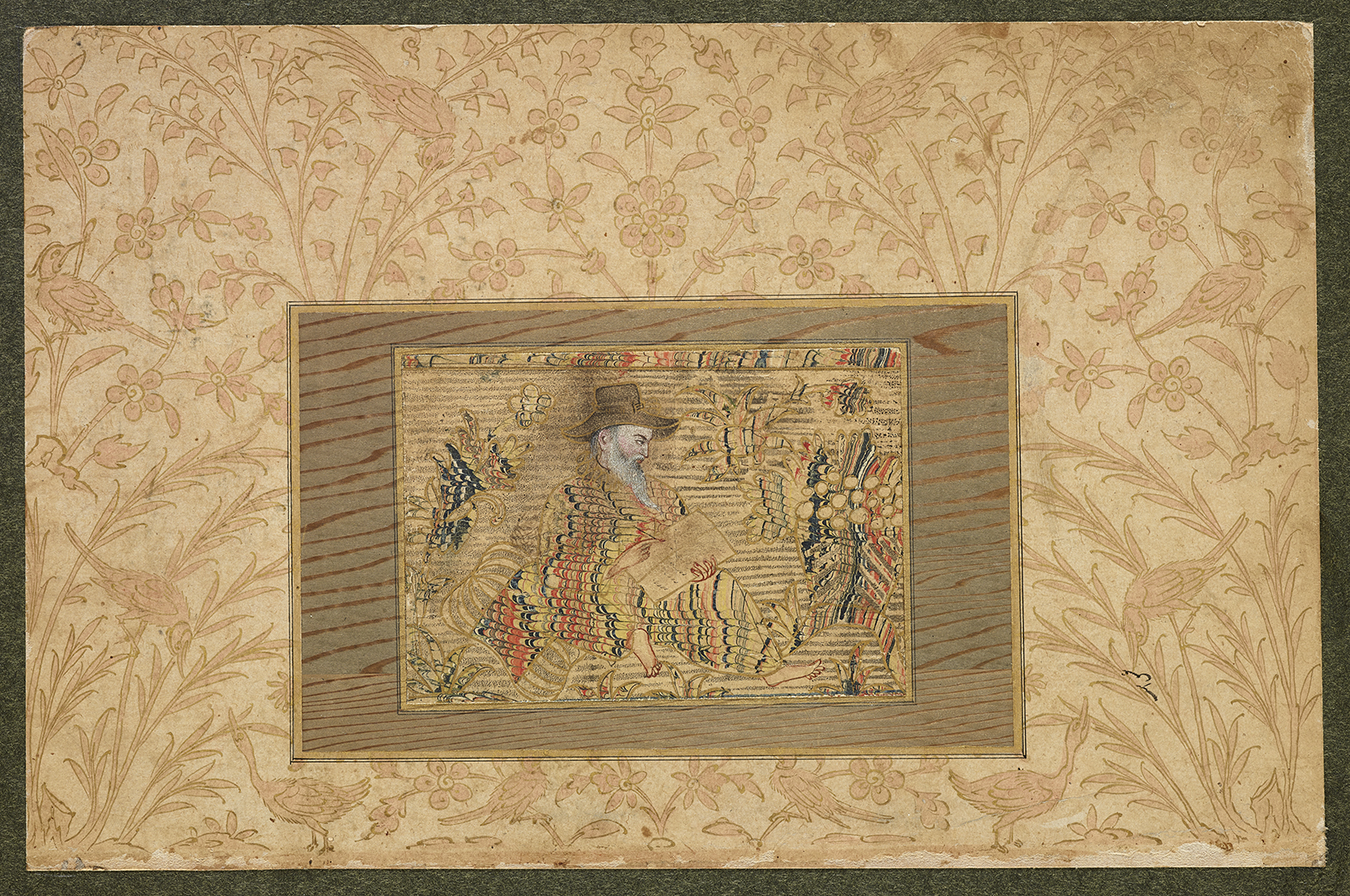Click on the image to zoom
A Portuguese Scholar
- Accession Number:AKM196
- Place:India, Deccan, Bijapur
- Dimensions:26.6 x 17.3 cm
- Date:ca. 1630
- Materials and Technique:opaque watercolour and gold on paper
In this single-page drawing, an aged bearded man sits on a striped cushion in a landscape, writing in a notebook. The uniqueness of this drawing lies in the marbling used to colour his clothes and the surrounding plants in the landscape, as well as the surrounding frame. The drawing is attached to a folio with birds and gold and pale orange flowering plants, and was presumably created for an album. The face and wide-brimmed hat of the figure are very European. The Deccani artists, who were specialists in the use of marbling for paintings and drawings, were also quite familiar with Europeans since the Portuguese had established their colony at Goa in 1510. Jesuit missionaries and travellers from Europe were part of daily life in that part of India. Some were visitors, while others chose India as a temporary residence. The artists of Bijapur were exposed to closer contact with Portuguese settlers.[1]
Further Reading
Iranian artists most commonly employed the topic of a scholar or doctor, as in a drawing in the Bibliothèque nationale, Paris by Reza-e ‘Abbasi.[2] Reza-e ‘Abbasi (ca. 1565–1635) joined the royal court workshop in Qazvin in 1587 from Isfahan, and he had an enormous impact on 17th-century artists. His innovative ideas opened new horizons in the creation of styles. A drawing inspired by ‘Abbasi’s work and presumably executed by his followers is kept in the Aga Khan Museum Collection (see AKM77). It is an adaptation of the Iranian topic with European elements.
The technique of marbling or “design in water” (abri in Persian) became popular with Western collectors. The first Western mention of this technique was by Francis Bacon in Sylva Sylvarum (1627), in which he states that it was a technique commonly used by Turks.[3] This quotation made the technique and the Ottoman artists famous in the Western world. Even in our own time it is still known as the Turkish technique. According to F.R. Martin, however, the technique actually originated in Tabriz, and was later introduced into 16th-century Ottoman art. [4] From Tabriz it also passed to India.[5] The Tabrizian artists who followed the invitation of Humayun could have brought this technique to the Mughal realm. Yves Porter assumes that it was Mir Mohammad Taher, an Iranian illuminator, who went to India and introduced marbled paper.[6] In the Deccan this technique grew from being used for the frame or ground paper to being central to the drawing.
Around 1625, marbled single-page drawings were in vogue in the Deccan, especially in Bijapur.[7] The Aga Khan Museum Collection has two astonishing examples of such Bijapur drawings: the present one and An Emaciated Horse Harassed by Birds (AKM908). They reveal not only the use of this technique but also the complexity and diversity of chosen topics.
— Filiz Çakır Phillip
Notes
[1] Esin Atıl, The Brush of the Masters: Drawings from Iran and India (Washington, DC: The Freer Gallery of Art, 1978), 129.
[2] Bibliothèque nationale, Paris, MS.Supp.Pers. 1572, folio 22; see also Sheila Canby, The Rebellious Reformer: The Drawings and Paintings of Riza-yi Abbasi of Isfahan (London: Azimuth Editions, 1996), 138, 196, cat. 100.
[3] Mark Zebrowski, Deccani Painting (London: Sotheby Publications, 1983), 135.
[4] F.R. Martin, The Miniature Painting and Painters of Persia, India, and Turkey from the 8th to the 18th Century (London: Quaritch, 1912; reprint London: Holland Press, 1968), 107; Zebrowski, 135.
[5] Yves Porter, Painters, Paintings, and Books: An Essay on Indo-Persian Technical Literature, 12th–19th Centuries, trans. S. Butani (New Delhi: Manohar, Centre for Human Sciences, 1994), 45; Martin, 107; Zebrowski, 135.
[6] Porter, 45; Adamova, 45–46.
[7] Porter, 49.
References
Adamova, Adel. Persian Manuscripts, Paintings and Drawings: From the 15th to the Early 20th Century in the Hermitage Collection. London: Azimuth editions, 2012. ISBN: 9781898592075
Atıl, Esin. The Brush of the Masters: Drawings from Iran and India. Washington, DC: The Freer Gallery of Art, 1978. ISBN: 9780934686297
Canby, Sheila. The Rebellious Reformer: The Drawings and Paintings of Riza-yi Abbasi of Isfahan. London: Azimuth Editions, 1996. ISBN: 9781898592051
Martin, F.R. The Miniature Painting and Painters of Persia, India, and Turkey from the 8th to the 18th Century. London: Quaritch, 1912 (reprint, London: Holland Press, 1968). https://archive.org/details/gri_33125007047463/page/n9
Phillip, Filiz Çakır. Enchanted lines: drawings from the Aga Khan Museum collection. 2014. ISBN: 9780991992874
Porter, Yves. Painters, Paintings, and Books: An Essay on Indo-Persian Technical Literature, 12th–19th Centuries, trans. S. Butani. New Delhi: Manohar, Centre for Human Sciences, 1994. ISBN: 978-8173047503
Zebrowski, Mark. Deccani Painting. London: Sotheby Publications, 1983. ISBN: 9780856671531
Note: This online resource is reviewed and updated on an ongoing basis. We are committed to improving this information and will revise and update knowledge about this object as it becomes available.


